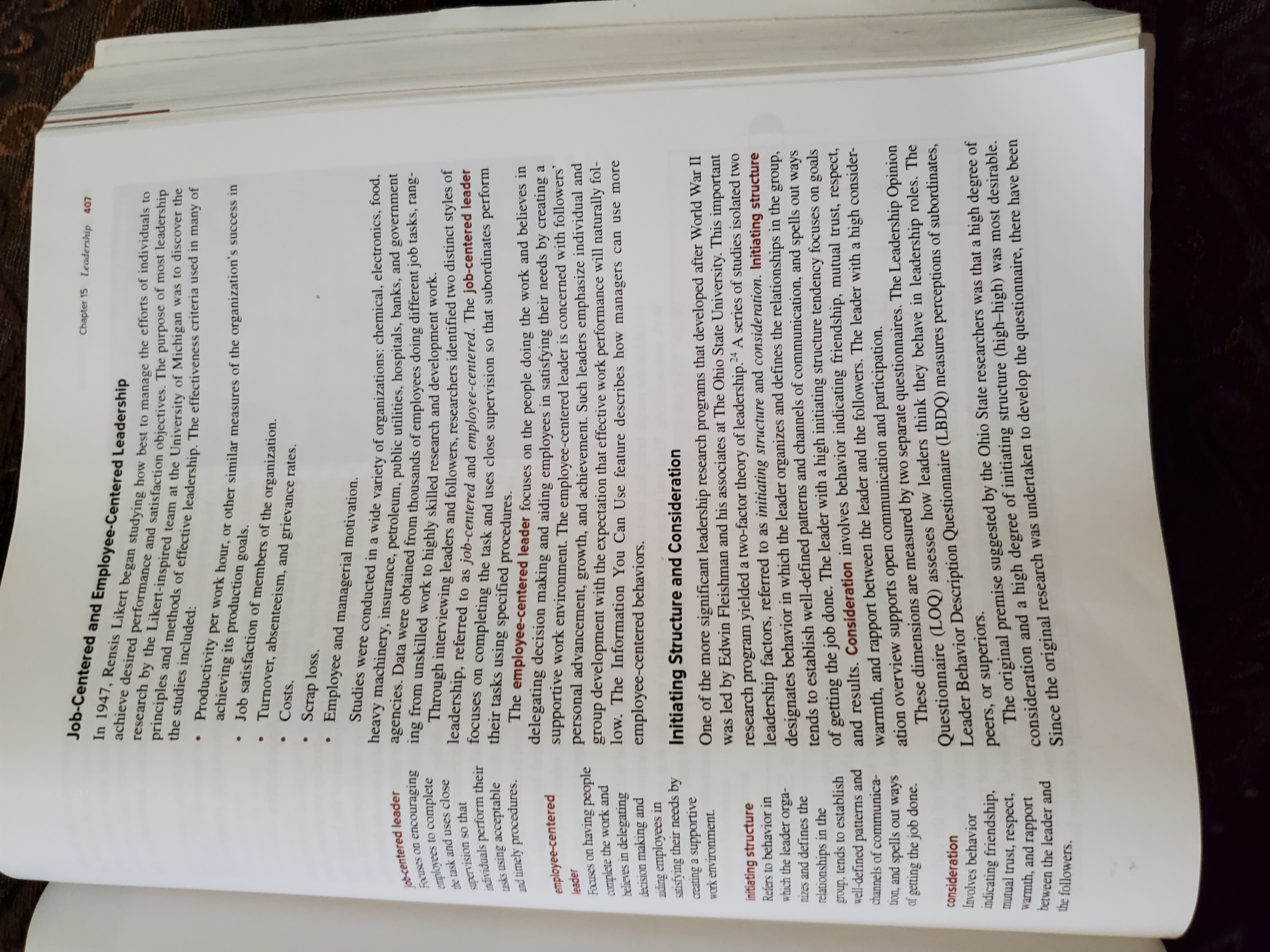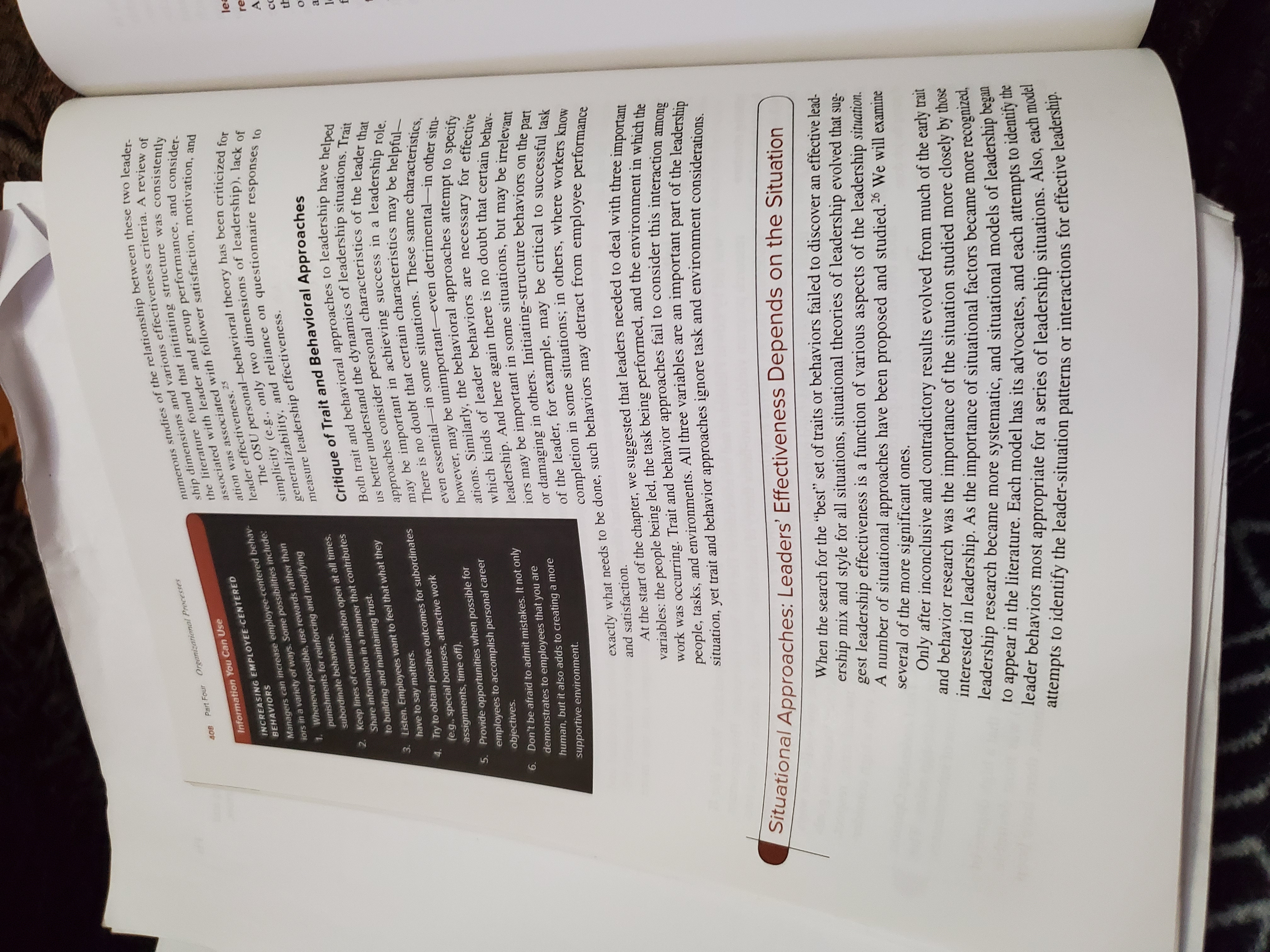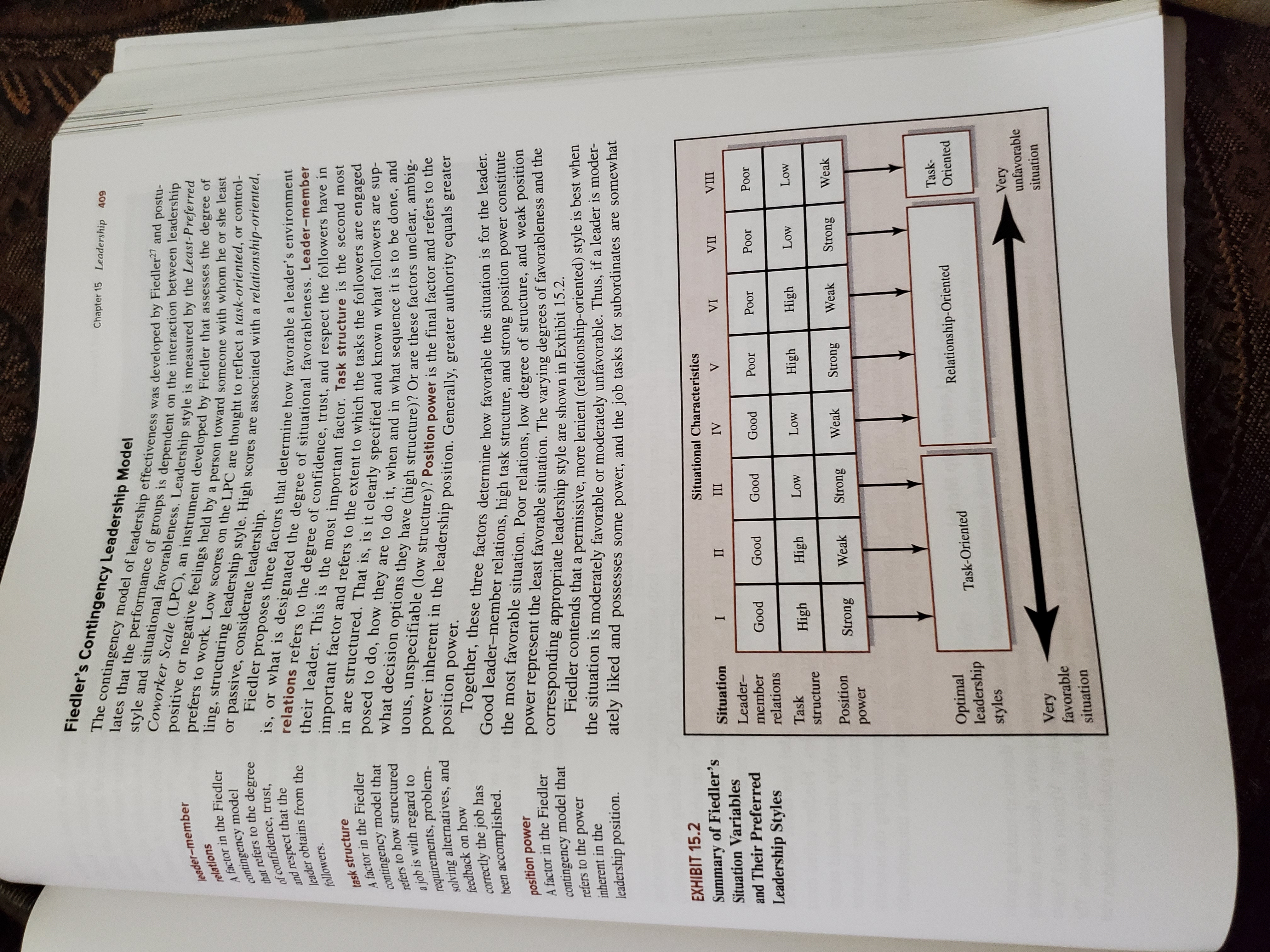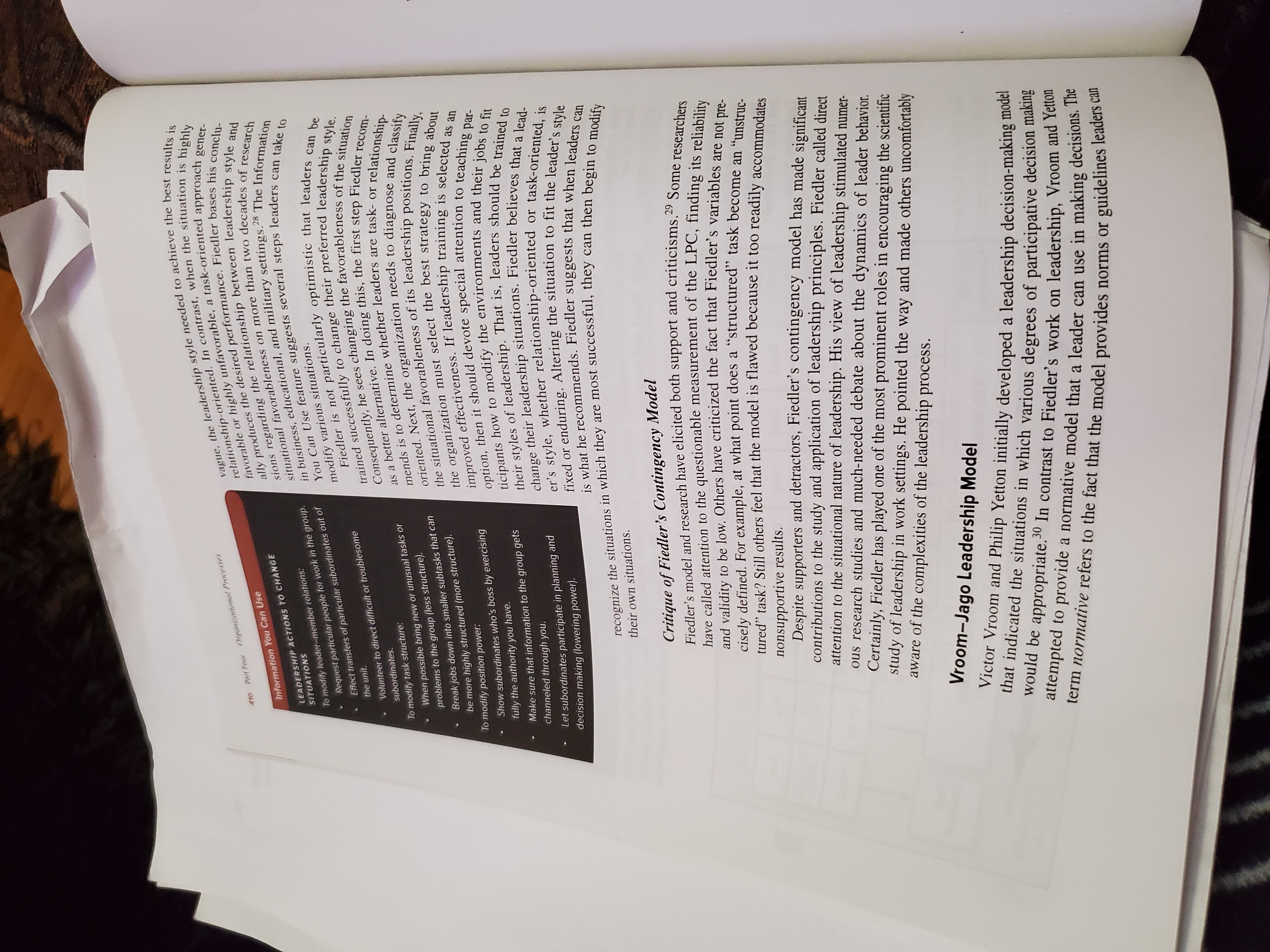Material that goes with the last question.
running-a clear indication that organizations value leadership and trait th OB MATTERS are willing to Invest In developing leaders. leader GE TOPS LIST OF BEST COMPANIES FOR LEADERS For more than 60 years, global conglomerate GE has made a strong commitment to developing leaders-starting when it opened An atte Chief Executive magazine recently announced its 2016 list of the Best Companies for Leaders, and for the second consecutive year, GE Is at the first corporate university and central hub for innovation, ideas, and specifi learning back in 1956. Today, the company offers onsite leadership (physic the top of the public company list , followed closely by EMC Insurance, development opportunities for its 300,000 employees in close to 200 onal Hitachi Data Systems , IBM, and Johnson Controls. For more than a leader decade, Chief Executive has surveyed both public and private compa nies worldwide with questionnaires and interviews to learn what they locations in more than 50 countries. The company spends more than a are doing to identify and nurture potential leaders three or more levels billion dollars annually in employee development and leadership training. down the organizational chart from the CEO. GE views leadership development as integral to the company's culture Criteria considered in evaluating companies include having a formal and future. According to company CEO Jeff Immelt, "We try to create eadership process in place; the CEO's commitment level to the leader- global leaders, people who can navigate the complexity of our times ship program, as measured by time spent developing leaders; the depth with clarity, courage, and integrity." of the leadership " pool," as measured by the percentage of senior pos tions filled by internal candidates ; and the number of other firms that Sources: Dan Weinfurter and J.P. Donlon, "2016 Best Companies for Leaders," eport recruiting employees from the company being evaluated. Chief Executive, http://chiefexecutive.net, accessed May 26, 2016; company web- Other key results from the 2016 survey suggest that more compa site, "The Future of Leadership," http://www.ge.com, accessed May 26, 2016; Jeff nies continue to recognize the importance of developing leaders a Immelt, "How to Differentiate Great Leaders from Good Leaders," Linkedin, https:/ part of their overall corporate strategy. In 2010, half of the firms sur- www.linkedin.com, accessed May 26, 2016; James Kosur, "GE Runs an Intense veyed said they had a formal leadership program in place. By 2016 5-Year Program to Develop Executives, and Only 2% Finish It," Business Insider, 82 percent of the companies had formal leadership programs up and October 5, 2015, http://www.businessinsider.com; Patricia Sellers, "The No. 1 Fortune 500 Leadership Trait Is...," Fortune, June 5, 2015, http:/fortune.com. effect on sales, profits, and profit margins. " Reanalysis of the same data found that leader- ship accounted for more variance in performance than did many of the other variables studied, but most of the variance is unexplained. "? Manz and Sims have clearly pointed out another wave of thinking that emphasizes the replacement of "bosses" with teams of employees who serve as their own bosses. 13 The concept has been labeled variously as self-managing teams, empowerment teams, and autonomous work groups. The teams described by Sims and Manz may not have bosses, but they do have leaders. As these organizational researchers state, "No successful team is without leadership." Manz and Sims have described "superleaders," individuals who lead others to lead themselves to higher levels of performance. Team leaders sometimes emerge or are sometimes appointed. They can be called coordinators, facilitators, or coaches. They the future. exert influence from a position of respect or expertise that is accepted by the other team members. The OB Matters shows that some companies work hard at grooming leaders for Trait Approaches: Leaders Are Born That Way Thinking and discussion about leadership have evolved over the years from a trait- based approach to the concept of teams without bosses. To understand this evolution in value in them. views of leadership, it is helpful to trace the historical foundations, some considered 404 today to be rather simplistic and some so complex that practitioners now find little Much of the early discussion and research on leadership focused on identifying intel- lectual, emotional, physical, and other personal traits of effective leaders. This approachChapter 15 Leadership 405 assumed that a finite number of individual traits of effective leaders could be found. To a trait theory of significant extent, the personnel testing component of scientific management supported the leadership An attempt to identify trait theory of leadership. 14 In addition to being studied by testing, the traits of leaders have hip and specific characteristics been examined by observation of behavior in group situations, by choice of associates made a physical, mental, per- voting), by nomination or rating by observers, and by analysis of biographical data. opened sonality) associated with Intelligence leadership success. as, and lership In a review of 33 studies, Ralph Stogdill found that leaders were more intelligent than followers. 's to 200 One significant finding, however, was that extreme intelligence differences between leaders than a and followers might be dysfunctional. For example, a leader with a relatively high IQ attempt- ining ulture ing to influence a group whose members have average IQs may be unable to understand why reate the members don't comprehend the problem. In addition, such a leader may have difficulty times communicating ideas and policies. A research study examined the relationship between leader ability and IQ in a population of police officers and suggested that although IQ is important for leaders, emotional intelligence (covered in Chapter 3) is a better predictor of leadership ability in certain contexts. 16 web- Jeff itps:// Personality Edwin Ghiselli reported several personality traits associated with leader effectiveness.' He found that the ability to initiate action independently was related to the respondent's level in the organization. The higher the person went in the organization, the more important this trait became. Ghiselli also found that self-assurance was related to hierarchical position in the organization. Finally, he found that persons who exhibited individuality were the most er- effective leaders. Studies continue to find a relationship between personality characteristics les and leader effectiveness. A recent study looked at the "Big Five" personality traits along with leader self-efficacy (the belief in one's potential for success) and several perceived job he characteristics. The study confirmed a relation between personality characteristics and leadership assessments; most notable was a strong relationship between leader self- efficacy and leader performance. Physical Characteristics Studies of the relationship between effective leadership and physical characteristics such as age, height, weight, and appearance provide contradictory results. Being taller and heavier than the group average is certainly not advantageous for achieving a leader position. However, some organizations believe a physically large person is needed to secure compliance from followers. This notion relies heavily on coercive power. None- theless, Truman, Gandhi, Thatcher, Napoleon, and Stalin are examples of individuals of small stature who rose to powerful leadership positions. Even when the use of phys- ical attributes was being promoted as a principal technique to select leaders, the method was questioned. A 1944 book on selection stated, "Do not fall into the error of judging character from facial or other physical characteristics," advocating instead other, more "scientific" approaches." While this decades-old advice is generally taken today as true, our understanding of scientific approaches has evolved to the extent that it may be questioned. In a study using pictures of company CEOs, subjects' facial evaluations of CEOs were found to be related to company performance.20 This study suggests the need for further research on the relationship between physical appearance and leadership outcomes.Abilities To enlist cooperation 406 Part Four Organizational Processes Personality To inspire action Adaptability To make decisions Intelligence Alertness EXHIBIT 15.1 To communicate effectively Traits Associated Judgment Creativity To be social with Leadership Decisiveness Personal integrity Effectiveness Knowledge Self-confidence To use tact and diplomacy Fluency of speech Emotional balance and control Sources: Molly Owens. ity Traits That Make ndependence (nonconformity) You an Effective be Preneur, http:/www careneur.com, accessed am 25, 2010. C Effective .. http:/www.the ipressed May 25. 2010 command M. Bass, Stogdill Handbook of Leade (New York: Free Press, 1982). Supervisory Ability pp. 75-76. using the leaders' performance ratings, Ghiselli found a positive relationship between supervisory ability and level in the organizational hierarchy." The supervisor's ab defined as the "effective utilization of whatever supervisory practices are indicated by the particular requirements of the situation."22 Once again, a valid measurement of the concept is needed-and finding such precision is still a difficult problem to resolve. Exhibit 15.1 summarizes a number of the most researched traits of leaders (traits found most likely to characterize successful leaders). Some studies have reported that ed that these traits contribute to leadership success. However, leadership success is neither primarily nor com- pletely a function of these or other traits. Although in some studies traits such as those in Exhibit 15. I have differentiated effect live from ineffective leaders, research findings are still contradictory for a number of pos- sible reasons. First, the list of potentially important traits is endless. Every year, new traits-such as the astrological sign under which a person is born, handwriting style, and order of birth-are added to personality, physical characteristics, and intelligence. This continual "adding on" results in more confusion among those interested in identifying leadership traits. Second, trait test scores aren't consistently predictive of leader effective- ness. Leadership traits don't operate singly to influence followers, but act in combination. This interaction influences the leader-follower relationship. Third, patterns of effective behavior depend largely on the situation: Leadership behavior that's effective in a bank may be ineffective in a laboratory. Finally, the trait approach fails to provide insight into what the effective leader does on the job. Observations are needed that describe the behav- ior of effective and ineffective leaders. Despite its shortcomings, the trait approach is not completely invalid. Kirkpatrick and Locke found evidence that effective leaders are different from other people.2 Their review of the literature suggests that drive, motivation, ambition, honesty, integrity, and self- confidence are key leadership traits. Kirkpatrick and Locke believe that leaders don't have traits to have a good chance to be effective. to be great intellects to succeed. However, leaders do need to have the "right stuff" or right Behavioral Approaches: Leaders' Actions Determine Their Effectiveness followers. In the 1940s, researchers began to explore the notion that how a person acts determines that person's leadership effectiveness. Instead of searching for traits, these researchers examined leader behaviors and their impact on the performance and satisfaction ofChapter 15 Leadership 407 Job-Centered and Employee-Centered Leadership In 1947, Rensis Likert began studying how best to ma st to manage the efforts of individuals to achieve desired performance and satisfaction objectives. The purpose of most leadership research by the Likert-inspired team at the University of Michigan was to discover the the studies included: principles and methods of effective leadership. The effectiveness criteria used in many of Productivity per work hour, or other similar measures of the organization's success in achieving its production goals. Job satisfaction of members of the organization. Costs. Turnover, absenteeism, and grievance rates. Scrap loss. Employee and managerial motivation. Studies were conducted in a wide variety of organizations: chemical, electronics, food, job-centered leader heavy machinery, insurance, petroleum, public utilities, hospitals, banks, and government Focuses on encouraging agencies. Data were obtained from thousands of employees doing different job tasks, rang- employees to complete ing from unskilled work to highly skilled research and development work. the task and uses close Through interviewing leaders and followers, researchers identified two distinct styles of supervision so that individuals perform their leadership, referred to as job-centered and employee-centered. The job-centered leader focuses on completing the task and uses close supervision so that subordinates perform tasks using acceptable their tasks using specified procedures. and timely procedures. The employee-centered leader focuses on the people doing the work and believes in employee-centered delegating decision making and aiding employees in satisfying their needs by creating a supportive work environment. The employee-centered leader is concerned with followers' leader Focuses on having people personal advancement, growth, and achievement. Such leaders emphasize individual and complete the work and group development with the expectation that effective work performance will naturally fol- believes in delegating low. The Information You Can Use feature describes how managers can use more decision making and employee-centered behaviors. aiding employees in satisfying their needs by Initiating Structure and Consideration creating a supportive work environment. One of the more significant leadership research programs that developed after World War II was led by Edwin Fleishman and his associates at The Ohio State University. This important initiating structure research program yielded a two-factor theory of leadership." A series of studies isolated two Refers to behavior in leadership factors, referred to as initiating structure and consideration. Initiating structure which the leader orga- designates behavior in which the leader organizes and defines the relationships in the group, izes and defines the tends to establish well-defined patterns and channels of communication, and spells out ways elationships in the of getting the job done. The leader with a high initiating structure tendency focuses on goals group, tends to establish well-defined patterns and and results. Consideration involves behavior indicating friendship, mutual trust, respect, channels of communica- warmth, and rapport between the leader and the followers. The leader with a high consider- tion, and spells out ways ation overview supports open communication and participation. of getting the job done. These dimensions are measured by two separate questionnaires. The Leadership Opinion Questionnaire (LOQ) assesses how leaders think they behave in leadership roles. The consideration Leader Behavior Description Questionnaire (LBDQ) measures perceptions of subordinates, Involves behavior indicating friendship, peers, or superiors. The original premise suggested by the Ohio State researchers was that a high degree of mutual trust, respect, consideration and a high degree of initiating structure (high-high) was most desirable. warmth, and rapport between the leader and Since the original research was undertaken to develop the questionnaire, there have been the followers.numerous studies of the relationship between these two leader- 108 Part Four Organizational Processes ship dimensions and various effectiveness criteria. A review of the literature found that initiating structure was consistently Information You Can Use associated with leader and group performance, and consider- INCREASING EMPLOYEE-CENTERED ation was associated with follower satisfaction, motivation, and BEHAVIORS leader effectiveness. 25 Managers can increase employee-centered behav- The OSU personal-behavioral theory has been criticized for iors in a variety of ways. Some possibilities include: simplicity (e.g.. only two dimensions of leadership), lack of Whenever possible, use rewards rather than generalizability, and reliance on questionnaire responses to punishments for reinforcing and modifying measure leadership effectiveness. subordinate behaviors. 2. Keep lines of communication open at all times. Critique of Trait and Behavioral Approaches Share information in a manner that contributes to building and maintaining trust. Both trait and behavioral approaches to leadership have helped Listen. Employees want to feel that what they us better understand the dynamics of leadership situations. Trait have to say matters. approaches consider personal characteristics of the leader that 4. Try to obtain positive outcomes for subordinates may be important in achieving success in a leadership role. (e.g., special bonuses, attractive work There is no doubt that certain characteristics may be helpful- assignments, time off). even essential-in some situations. These same characteristics, 5. Provide opportunities when possible for however, may be unimportant-even detrimental-in other situ- employees to accomplish personal career ations. Similarly, the behavioral approaches attempt to specify objectives. 6. Don't be afraid to admit mistakes. It not only which kinds of leader behaviors are necessary for effective demonstrates to employees that you are leadership. And here again there is no doubt that certain behav- human, but it also adds to creating a more lors may be important in some situations, but may be irrelevant supportive environment. or damaging in others. Initiating-structure behaviors on the part of the leader, for example, may be critical to successful task completion in some situations; in others, where workers know and satisfaction. exactly what needs to be done, such behaviors may detract from employee performance At the start of the chapter, we suggested that leaders needed to deal with three important variables: the people being led, the task being performed, and the environment in which the work was occurring. Trait and behavior approaches fail to consider this interaction among people, tasks, and environments. All three variables are an important part of the leadership situation, yet trait and behavior approaches ignore task and environment considerations. Situational Approaches: Leaders' Effectiveness Depends on the Situation When the search for the "best" set of traits or behaviors failed to discover an effective lead- ership mix and style for all situations, situational theories of leadership evolved that sug- gest leadership effectiveness is a function of various aspects of the leadership situation. A number of situational approaches have been proposed and studied. 2 We will examine several of the more significant ones. Only after inconclusive and contradictory results evolved from much of the early trait and behavior research was the importance of the situation studied more closely by those interested in leadership. As the importance of situational factors became more recognized, leadership research became more systematic, and situational models of leadership began to appear in the literature. Each model has its advocates, and each attempts to identify the leader behaviors most appropriate for a series of leadership situations. Also, each model attempts to identify the leader-situation patterns or interactions for effective leadership.Fiedler's Contingency Leadership Model Chapter 15 Leadership 409 The contingency model of leadership effectiveness was developed by Fiedler and postu- lates that the performance of groups is dependent on the interaction between leadership leader-member style and situational favorableness. Leadership style is measured by the Least-Preferred elations Coworker Scale (LPC), an instrument developed by Fiedler that assesses the degree of A factor in the Fiedler positive or negative feelings held by a person toward someone with whom he or she least contingency model prefers to work. Low scores on the LPC are thought to reflect a task-oriented, or control- that refers to the degree ling, structuring leadership style. High scores are associated with a relationship-oriented, or passive, considerate leadership. of confidence, trust, and respect that the leader obtains from the Fiedler proposes three factors that determine how favorable a leader's environment followers. is, or what is designated the degree of situational favorableness. Leader-member relations refers to the degree of confidence, trust, and respect the followers have in task structure their leader. This is the most important factor. Task structure is the second most A factor in the Fiedler important factor and refers to the extent to which the tasks the followers are engaged contingency model that in are structured. That is, is it clearly specified and known what followers are sup- refers to how structured a job is with regard to posed to do, how they are to do it, when and in what sequence it is to be done, and requirements, problem- what decision options they have (high structure)? Or are these factors unclear, ambig- solving alternatives, and uous, unspecifiedle (low structure)? Position power is the final factor and refers to the feedback on how power inherent in the leadership position. Generally, greater authority equals greater position power. correctly the job has been accomplished. Together, these three factors determine how favorable the situation is for the leader. Good leader-member relations, high task structure, and strong position power constitute position power A factor in the Fiedler the most favorable situation. Poor relations, low degree of structure, and weak position contingency model that power represent the least favorable situation. The varying degrees of favorableness and the refers to the power corresponding appropriate leadership style are shown in Exhibit 15.2 inherent in the Fiedler contends that a permissive, more lenient (relationship-oriented) style is best when leadership position. the situation is moderately favorable or moderately unfavorable. Thus, if a leader is moder- ately liked and possesses some power, and the job tasks for subordinates are somewhat EXHIBIT 15.2 Summary of Fiedler's Situational Characteristics Situation II Situation Variables IV VI VII VIII and Their Preferred Leader- member Good Good Good Good Poor Poor Poor Leadership Styles Poor relations Task High High Low Low High High Low Low structure Position Strong Weak Strong Weak Strong Weak Strong Weak power Task- Optimal Relationship-Oriented Task-Oriented Oriented leadership styles Very unfavorable Very situation favorable situationvague, the leadership style needed to achieve the best results is 410 Part Four Organizational Processes relationship-oriented. In contrast, when the situation is highly favorable or highly unfavorable, a task-oriented approach gener- Information You Can Use ally produces the desired performance. Fiedler bases his conclu LEADERSHIP ACTIONS TO CHANGE sions regarding the relationship between leadership style and SITUATIONS situational favorableness on more than two decades of research To modify leader-member relations:" in business, educational, and military settings.28 The Information . Request particular people for work in the group. You Can Use feature suggests several steps leaders can take to Effect transfers of particular subordinates out of modify various situations. the unit. Fiedler is not particularly optimistic that leaders can be Volunteer to direct difficult or troublesome trained successfully to change their preferred leadership style. subordinates. Consequently, he sees changing the favorableness of the situation To modify task structure: When possible bring new or unusual tasks of as a better alternative. In doing this, the first step Fiedler recom- problems to the group (less structure). mends is to determine whether leaders are task- or relationship- Break jobs down into smaller subtasks that can oriented. Next, the organization needs to diagnose and classify be more highly structured (more structure). the situational favorableness of its leadership positions. Finally, To modify position power: the organization must select the best strategy to bring about Show subordinates who's boss by exercising improved effectiveness. If leadership training is selected as an fully the authority you have. option, then it should devote special attention to teaching par- Make sure that information to the group gets ticipants how to modify the environments and their jobs to fit channeled through you. their styles of leadership. That is, leaders should be trained to Let subordinates participate in planning and change their leadership situations. Fiedler believes that a lead- decision making (lowering power). er's style, whether relationship-oriented or task-oriented, is fixed or enduring. Altering the situation to fit the leader's style is what he recommends. Fiedler suggests that when leaders can recognize the situations in which they are most successful, they can then begin to modify their own situations. Critique of Fiedler's Contingency Model Fiedler's model and research have elicited both support and criticisms." Some researchers have called attention to the questionable measurement of the LPC, finding its reliability and validity to be low. Others have criticized the fact that Fiedler's variables are not pre- cisely defined. For example, at what point does a "structured" task become an "unstruc tured" task? Still others feel that the model is flawed because it too readily accommodates nonsupportive results. Despite supporters and detractors, Fiedler's contingency model has made significant contributions to the study and application of leadership principles. Fiedler called direct attention to the situational nature of leadership. His view of leadership stimulated numer- ous research studies and much-needed debate about the dynamics of leader behavior. Certainly, Fiedler has played one of the most prominent roles in encouraging the scientific study of leadership in work settings. He pointed the way and made others uncomfortably aware of the complexities of the leadership process. Vroom-Jago Leadership Model Victor Vroom and Philip Yetton initially developed a leadership decision-making model that indicated the situations in which various degrees of participative decision making would be appropriate. 30 In contrast to Fiedler's work on leadership, Vroom and Yetton attempted to provide a normative model that a leader can use in making decisions. The term normative refers to the fact that the model provides norms or guidelines leaders can













